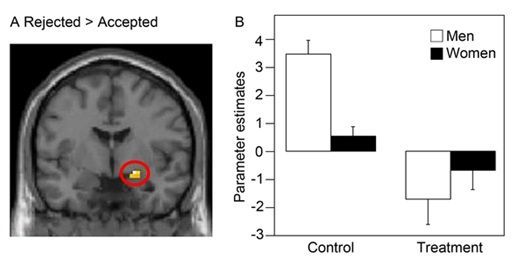Article
Reacting to Unfairness: One Gender is More Sensitive
Author(s):
A study with money shows how the brain reacts to unfairness and reveals that males are more sensitive to unfair monetary offers than females.
Economic researchers know how to have fun. They often have their research participants play games (with a purpose of course).
One such sport is called the Ultimatum Game. In it, two players decide between themselves how to divide money provided to them. The tricky part is that the first player determines how to parcel up the money and the second participant can accept or reject the proposition. If the second player accepts the proposal of the first, the money is divided accordingly. If she or he does not, neither party receives anything.
If the cash is not divided somewhat equally by the first player, unfairness is often perceived by the second. When brain function is studied at the same time using functional magnetic resonance imaging (FMRI) the amygdala is activated. Since this structure is important in the processing and recall of emotional reactions (fear, for example) it is not surprising that it is stimulated. It is a component of the emotional make up of the brain.
The early pioneers discovering this association were Katarina Gospic and her colleagues from several academic institutions in a paper entitled “Limbic Justice — Amygdala Involvement in Immediate Rejection in the Ultimatum Game.” They measured subcortical brain activity during early decision making in the Ultimatum Game as described above. They also introduced an intervention, benzodiazepine, an anxiolytic.
When participants were given this medication, the enhanced amygdala response during unfair offers was attenuated. This was in spite of the fact that unfairness continued to be perceived. The authors concluded that “the act of immediate rejection seems to be mediated by the limbic system (the amygdala is part of it) and is not solely driven by cortical processes… We propose that the amygdala is involved in instant rejection of unfair Ultimatum Game offers.”
n =
There is another part of this study that is fascinating. The refusal of unfair proposals was associated with higher FMRI activity in the right amygdala in the non-medicated or placebo group (6 — see below image).
n =
n =
Further, the difference between sexes for unfair versus fair proposals was statistically significant for men (males, 5; females, 12 — below) suggesting that they were more sensitive than women to unfair monetary offers. They also had a statistically greater response to benzodiazepine treatment than the women.

From PLoS Biology: A. The rejection of an unfair proposal was associated with a higher activity in the right amygdala B. Females and males showed significant differences in their response both under control test conditions and during benzodiazepine treatment.
“We are the first, to our knowledge, to show the functional anatomical response to unfair proposals…” the authors wrote. “Our results suggest that the act of immediate rejection of unfair proposals is driven by a phylogenetically old structure (the amygdala) and may be viewed as a reactive aggressive response.”
I asked the lead author via email why there was a male/female difference in this reaction.
We cannot say for sure what the gender difference is due to, but if I speculate I would guess that it is the testosterone that make men’s amygdala react more to unfairness (it is known that testosterone can increase amygdala activity),” she replied. “However, we do not see any behavioral differences. This may be because men have learned to regulate their initial amygdala response.”
“
Read more:
Swindled Seniors: A Specific Brain Abnormality May Be the Cause
How an Economist Changed Public Policy for the Better




